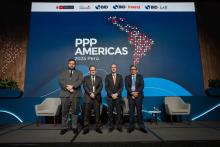
The lack of road infrastructure and geopolitical disputes cloud China's emblematic project on the Peruvian coast, whose inauguration is scheduled for the next APEC summit, to be held in November in Lima.
The arrival of the new year for the Peruvian economy comes loaded with the inauguration of a million-dollar project that has generated mixed opinions. This is the Port of Chancay, the commitment of Cosco Shipping Ports, one of the largest public companies in China, to speed up trade between Beijing and South American countries. The Asian consortium has a 60% stake in the port, compared to the 40% of the Peruvian Volcan Compañía Minera.
The ambitions for this terminal located 70 km north of Lima are great: it would mobilize one million containers per year in a first stage and, in successive expansions, it is expected to reach 1.5 million. Similarly, commercial ships could travel to Shanghai, China, in just 23 days, compared to the usual range of 35 to 40 days.
Cosco Shipping has maintained the goal of opening the port by the last quarter of 2024, just in time for the organization of the Presidential Summit of the Asia-Pacific Economic Cooperation Forum (APEC), which will take place in Lima. However, these expectations could be cut short by a series of infrastructure deficiencies that have emerged in recent weeks. To begin with, although the Peruvian government hopes that Chancay will be part of a regional hub along with Callao and Ica, to date there is no known progress on any state plan that facilitates cargo transportation between the aforementioned ports.
PENDING WORKS
At an event at the College of Engineers of Peru (CIP), Gonzalo Ríos Polastri, deputy general manager of Cosco Shipping, highlighted that the port of Chancay was linked to six other key infrastructure projects promoted by the Peruvian State. Among them are initiatives such as the Cercanías Train, a 323 km railway that seeks to connect Lima and Ica; the Sayán-Oyón-Ambo-Huánuco-Pucallpa highway, which would connect the Peruvian jungle with Lima; and the Huaral-Acos-Huallay-Cerro de Pasco route, which will do the same between the Peruvian capital and the mining department of Pasco.
The other pending projects include the Ancón Industrial Park, the Periférico Road Ring and the Pasamayo road pair. Ríos maintained that if the Peruvian State wants Chancay to have the desired logistical effect, these works should be promoted. In fact, they are already in the Logistics Infrastructure Plan. However, regardless of the promises of modernity and profits, several business associations have protested the lack of progress.
Thus, the Lima Chamber of Commerce (CCL), the Association of Exporters (Adex) and the Council of Users of the International Physical Distribution System (Conudfi) have declared that there is no known road project underway to facilitate land transportation. cargo to Chancay. Such is the concern that Julio Pérez, president of Adex, declared to the local media Gestión that, if the current state of connectivity and road infrastructure is maintained, Chancay will not become a regional foreign trade hub .
As for the international connection, there are more visible alternatives, although they are equally demanding for Peru. For example, Carlos Estremadoyro, former Minister of Transportation and Communications of the Andean country, proposed that Chancay establish a connection with the bioceanic train. This project aims to connect Bolivia and Brazil, in order to facilitate trade between the Atlantic and the Pacific. It was agreed in 2023 by the governments of both countries with a view to establishing a railway connection that reduces costs and times in international cargo transportation.
It should be noted that this initiative can materialize in the short term, since Brazil would only have to build a railway section to the Paraguay - Paraná Waterway to connect with Bolivia. While the highland country determined in the Economic and Social Development Plan (PDES) 2021-2025 that “all the works that are missing to be able to connect the eastern (railway) branch with the western one” are a priority. The only thing missing is for Peru to resume its own plan to complete the Bioceanic Train by connecting Bolivia with the southern port of Ilo.
A POSSIBLE TROJAN HORSE?
On the other hand, the great potential of a Chinese port in Peru has been the subject of controversy. In recent months, the phrase “from Chancay to Shanghai” has resonated as an echo of the progress that the work implies for the region, but also as a reminder of the unique presence that China will achieve on the Peruvian coast. In October 2023, a report from the Financial Times newspaper took the statements of an anonymous senior US official, who expressed concern that the “Peruvian government is not sufficiently focused on analyzing the benefits and threats to the country.”
The manager alluded to the fact that the entire infrastructure of the port of Chancay remains in the hands of a foreign power like China. Furthermore, the vast capacity of a deep-water port like Chancay could make it a military base for Chinese warships. At the time, the Peruvian government minimized the questions, to the point that Transportation Minister Raúl Pérez-Reyes maintained that his nation “is a sovereign country and establishes its international relations on that basis.”
Today, with a new year in tow, the port of Chancay stands as a great bet for those involved. However, its geopolitical implications and the lack of public policies on the part of the Peruvian Executive leave in doubt whether the benefit will ultimately be equitable.










